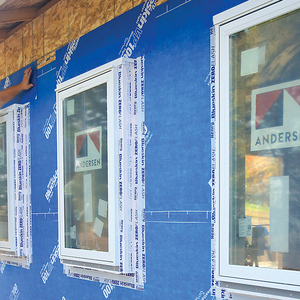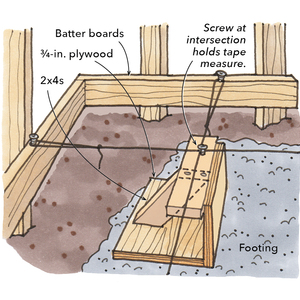I’ve been living here in the Charlotte, NC (Huntersville) for approximately 15 years now. I still can’t understand why all of the asphalt shingled roofs do not have a drip edge. The shingles are simply allowed to “droop” over the edges of the fascia. I’m sure that it simply doesn’t matter in the long run, but it just looks sloppy. As if it lacks attention to detail.
Can anyone comment?



















Replies
The builder/roofer saved $100/house skipping the drip edge. There's probably no felt under the shingles, either.
GRANTT LOGANN - THE LEXINGTONVILLE COPPERWRIGHT
http://grantlogan.net/
That'd be my guess.
Grant -
I think some of it's geographic. On Long Island, many of the older homes and many of the really newer ones do not have a drip edge. It seems to be used mostly on reroofs around here where there are multiple layers that aren't being stripped. I personally have not made a habit of using it - and I do put paper under the shingles.
Don K.
EJG Homes Renovations - New Construction - Rentals
Sometimes around here (Buffalo) I'll see drip edge on top of the shingles on the rake - drives me nuts!Bear
Read the instructions on the shingle package - that what it says on several brands.
That's probably cheap ice protection.
Needless to say, I'm going to use a drip. Thanks for all of the responses.RickO
Roofers around here charge about $1.25 a foot for drip edge so it ends being more in the range of $200 to $300 for a smalish house. I guess a McMasnion could be as much as a $grand.
Many many homes in Charleston which have felt do not have drip edge.
Part of not using metal drip edge with asphalt shingles goes back to not needing it with cedar shingles. We don't have a lot of cedar roofs locally but, on lower budget asphalt shingle projects it's an easy corner to cut.
"Let's go to Memphis in the meantime, baby" - John Hiatt.
GRANTT LOGANN - THE LEXINGTONVILLE COPPERWRIGHT
http://grantlogan.net/
early 90's in that area, no drip, felt not reqired over 6-on-12 left there in 94
I wouldn't think of doing a new roof or re-roof without drip edge, in fact when we strip, we take the old drip edge, if rotted or deformed and replace. It costs about 5 bucks or less for a 10' peice and takes little time to put on. It also acts as a water break in my mind, but hey if the shingles drooping works fine for them, then whatever.
In my mind t'would make a house look a bit like the woodshed out back, but that's my opine. I've seen many house without underlayment and usually comes along with poorly nailed shingles that rip off in a good wind.
And yes, drip edge is oft used to hide multi layers of shingles, but around here, no more than two layers is allowed so that extra wide drip edge doesn't such a hot seller, at least for those who go by code.
To my mind, the two purposes of rake metal & drip edge are to directly protect the edge of the roof sheathing from the elements (the edges are always somewhat absorbent) and to act as a water break- wind pushs the drips up under the shingles to the drip edge, then they roll down to the bottom of the metal and even a strong wind won't push them up the backside where they can get into the edge of the sheathing.
If the rake metal is on top of the shingles, a quartering wind will push the water under the metal and around the edge of the shingle, where it can then creep (capillary action) back to the sheathing and start rotting the edge.
If one is in a high wind area and feels it's necessary to use the rake metal to hold down the rake edges of the shingles, use two pieces, one under the shingles and one over, but remember the nails that hold the one on top are providing a direct water path to the sheathing. Better to tack the edges with roofing cement.
Edited 8/31/2006 2:48 am ET by BobboMax
On that subject, when I worked in west texas, we used a gravel gaurd for hot BUR on the rakes, then plastic roof cement to seat the shingles. The face of the gravel gaurd metal stands up to block wind blown rain. from driving in and the puikey keeps wind from ripping up shingles. I don't think I've ever lived in a windier area.Seems like eveey time this no-drip subject comes up, it is mostly the folks in Georgia and the Carolinas that leave it off, and the reason is always the poor-boy thinking.
Welcome to the Taunton University of Knowledge FHB Campus at Breaktime. where ... Excellence is its own reward!
Off the wall question: Isn't "plastic roof cement" actually a bituminous product? If so, I wonder why they call it that - I guess because of it's consistency?
the term plastic simply means maleable or workable. something between liquid and solid. At first, concrete is in a "plastic" state when first placed.The roof roof indicates what it is made to be used on.Cement indicates that it will stick things together like portland cement is the bonding agent in masonry.
Welcome to the Taunton University of Knowledge FHB Campus at Breaktime. where ... Excellence is its own reward!
"If the rake metal is on top of the shingles, a quartering wind will push the water under the metal and around the edge of the shingle, where it can then creep (capillary action) back to the sheathing and start rotting the edge. "Your analysis of wind driven water seepage seems congruent with mine, 'cept for one major detail: we apply drip directly onto the sheathing, then a layer of ice and water sheild is laid on the eave sides and then we lay the paper over and then proceed with the shingles. Also, nailing on a drip edge is done only to the extent needed for securing in place, about every five feet, so as to minimize penetrations. Drip edge is put in place so that the crease points out slightly from the sheathing edge, allowing for a drip off -- hence the name.Seeing someone apply drip edge over the shingles would serve up comedy that no doubt would quickly gain legendary status around here.
"Ice & water shield?" What's that*? I live in Portland, OR, and we pretty much keep our ice in the fridge. I guess a few people put it in their Scotch.
*Actually, I know what it is, but only because I read construction mags written by yankees. I can get it in narrow strips for flashing windows, etc, but I think I'd have to special order the 36" rolls.
"Ice & water shield?" What's that*? I live in Portland, OR, and we pretty much keep our ice in the fridge. I guess a few people put it in their Scotch.*Actually, I know what it is, but only because I read construction mags written by yankees."Believe it or not, I've had some people insist that we place the stuff on their entire roof -- until I give them the cost difference and the lack of usefulness up there along the roof. Its good protection against ice dams, which I guess you westerners don't worry too much about. We also frame with SPF #2, I hear you people use doug fir out there. We order doug fir for special structural use. Although a seventies era garage my partner and I just took down last spring had doug fir corner posts. I could use a scotch on the rocks about now.
I live on the coast of oregon, 50 percent of the time i put the drip edge over the top on the rakes, Why because thats what guys have done here and the people insist on it figuring it stops the edge from blowing off, I think the right way is under and go out with a bleeder strip 3 4 of an inch. Sometimes ya just cant fight it so i give up if thats what lola wants thats what lola gets
So, does the sheathing edge rot more if the drip edge is on top of the shingles? I suspect no myself, but I have never seen a drip edge on top of the shingles on any house ever in Dayton, OH. Or actually no where else, but it's something I never looked for. Now I keeep looking to see if I can find one.
You're gonna have to look long and hard. I've never seen it done like that.
"Let's go to Memphis in the meantime, baby" - John Hiatt.
http://grantlogan.net/
Was going to post to this thread last week, but ran out of time.
Just put a new roof on my cabin last month, and put the sloped dripedges over the shingles, based on case history of that particular cabin. Rain forest climate means different methods.
See Great moments, FHB , Nov 1990 for description of original roof.
Cabin is near Mt. St Helens in the rain forest. Original roof had no drip edge on the sides, 1 inch overhang of asphalt roofing.
After 15 years, enough moss buildup UNDER the roofing overhang on the asphalt that water wicked back onto the plywood, needed to replace some sections of plywood. At the eaves, despite the 1-1/2 by 1-1/2 galv drip edge there, similar wicking.
The fixes - ripped some old 10 inch by 10 inch galv ducting into 5" by 5" drip edge. Under the eaves put 4" by 10" galv angle, 10" part up under roofing. About 7/12 slope.
Side edges laid the 5 in. drip edge OVER the roofing in a fat bed of roofing cement. The last 25 years experience with the rain forest moss is that unless there is a large exposed galvanized surface, the moss will grow around the edge anyway and wick under between th roofing and drip edge.
Should last till I die this time.
I have never seen rot with the drip on top, I have never seen the drip on top anywhere else in America, but to be fair we have 100 mph winds here and i think they thought it would stop the edge shingles from blowing off. 50 percent of old houses have it on top but newer under now, Its hard to sell a job when they see the houses on there block a certain way but i recommend under but do it the way they want, I cant change the world sometimes. Much better under.
When I was first learning we never used a metal drip edge. We rabbeted the fascia board to accept the show board. Several years later I was told the city started requiring the builders to install a metal drip edge. The man who taught me was from Finalnd and came to the US in 1945. He had never used a metal drip edge and not one time had we ever had rot problems. A lot of what is done today is because of poor workmanship. I have always painted fascia board and any show board before installing it. As a result I have never had any problem. Personally I think a metal drip edge looks like poor compared to a nicely rabbeted fascia board covering the end of the show board.
There are buildings which I built years ago and have never had any problems but the city still required the drip edge when it was reroofed.
About 1990 is when I began to notice a lot of probelms with new buildings. So many contractors have not had proper training. They are simply paper pushers.